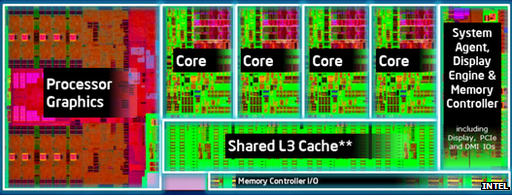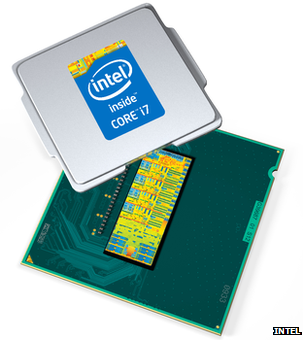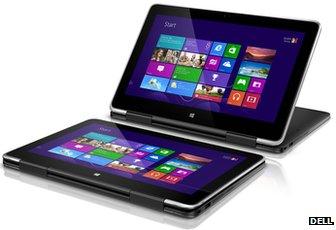Intel Haswell processors offer 'longer battery life'
- Published

Intel says its new chips were designed from "the ground up" to offer better battery life
Intel has formally launched its Haswell family of processors.
The firm says the chips offer improved battery life and a leap in graphics power over the previous generation.
Intel is the leading PC chip-maker and its product refreshes typically spur on new laptop and desktop sales. Computers using the chips have already been unveiled at the Computex tech show.
However, studies suggest the market is in decline because of competition from smartphones and tablets.

Intel says the integrated GPU offers double the performance of its equivalent in Ivy Bridge
Most smart devices are powered by chips based on designs by the British firm ARM rather than the x86 architecture used by Intel.
Even so, Intel said Haswell would allow laptops and two-in-one devices - offering both a laptop and tablet experience - to become thinner and last longer between charges, increasing their appeal.
It added that one version of the new chips featured CPU (central processing unit) cores which used just six watts of scenario design power - its power usage during "regular" tasks.
Intel said this was low enough for Haswell to be used in "cooler, quieter, fanless designs".
The amount of heat given off by the previous generation, Ivy Bridge, had meant that two fans needed to be included in the design of Microsoft's Surface Pro tablet.
Haswell tocks
Haswell - or the fourth generation Intel Core processors, as the family is formally known - marks the "tock" in the US firm's regular "tick-tock" development cycle.
This refers to the fact that its improvements centre around a new chip architecture rather than a change to its transistors.

Intel's Tom Kilroy gave details of Haswell's performance at Taiwan's Computex tech show
The firm says the new design of the family's CPU cores is capable of delivering a 15% boost in performance, a 50% improvement in active-use battery life, and up to three times the amount of standby battery life when compared to the performance of Ivy Bridge.
In addition, it says versions of the chip which include its new integrated GPU (graphics processing unit) - which it calls Iris - offer twice the performance when handling complex tasks such as generating 3D graphics or encoding high definition video.
For some users, that will mean they do not need a separate graphics card - something that adds to the bulk and cost of a computer.
It could also help drive the roll-out of laptops with higher resolution screens. These make more demands on a chip's GPU because more pixels are involved.
Some reviews of Apple's 13in Macbook Pro with Retina Display, external - which relies on Ivy Bridge's less powerful integrated GPU to drive its 226 pixels per inch (ppi) screen - suggested that the laptop struggled to cope in some situations.
Watch: Asia's biggest computer show begins in Taipei, with buyers looking for the latest trends in the computer industry.
However, Nvidia - a GPU card maker - has already warned Haswell has limits of its own.
"Any serious gamer will tell you that integrated graphics is far from adequate for delivering a reasonable, let alone good experience," it said, external. "Haswell won't change that."
Longer lasting
Intel boasts that the improvement in battery life is the biggest such gain in its history.
The company says it was able to do this because Haswell is more aggressive at cutting voltages to the parts of its architecture that do not need it.
"If someone is typing on their PC, we can literally shut everything down when it's not being used and then immediately bring it back up again in between the keystrokes," Navin Shenoy, vice president of the Intel Architecture Group, told the BBC.
"The system is smart enough to know it's not being used for those nanoseconds. That's the kind of granular power management at the chip level that we've never had before."

Dell's two-in-one laptop/tablet is one of the first computers to feature Haswell
Intel has achieved this by integrating a voltage regulator into its chip's architecture for the first time. In the past as many as seven additional third-party chips were needed to take care of this task. An added benefit is that space is saved inside the computer.
Mr Shenoy added that his firm had also worked with companies who make other components used in PCs to ensure they are optimised to complement Haswell's power regulation abilities.
ARM's challenge
Intel says Haswell marks a "radical change" to its processor line-up, but it also highlights the continuation of a long-running business strategy.
"Intel has always held onto the value of its chips by integrating more components," said Sergis Mushell, a computer chip expert at the tech consultancy Gartner.
"It takes parts that were previously discrete - such as the need for a separate GPU - and builds them in. It's the only way the firm can protect its margins."
But another analyst warned that Intel might struggle to repeat past profits.
.jpg)
Samsung's Galaxy Tab 3 is one of the few Android tablets to be powered by an Intel chip
"Intel and the other x86-chip maker AMD both have a huge problem: they are trying to sell processors for computers into a market where people have increasingly lost interest," said Chris Green, principal technology analyst at Davies Murphy Group Europe.
"People don't want PCs in the same volumes they did, and are increasingly going for ARM-based smart devices instead.
"Windows 8 has also failed to deliver the traditional uplift in PC sales which you'd expect from a new version of Microsoft's system making it even harder for Intel to ship large quantities of its processors to PC-makers - and Apple Macs and Linux PCs have not been able to mop up the slack."
However, Mr Mushell was more optimistic noting that the Haswell line-up would soon be joined by a cheaper range of Intel chips - codenamed Bay Trail - which he said had a good chance of appearing in Android devices.
- Published3 June 2013
- Published11 September 2012
- Published23 April 2012
- Published4 May 2011